- Life top
- Daily Life
- Applying for LINE stickers
- Exhibition of Matsumoto-sensei
- Hana - Shiba-Inu
- Elec. handicraft & Akihabara
- Supermarkets in the area
- Takaido Civic Center
- Building a house
- Horrible dentists
- Judo therapy
- In an elderly care home
- Parties
- Cosplay bonenkai 2010
- Gainax cosplay bonenkai
- Friends from Gainax
- Friends from schooldays
- Party at Bar Espion
- Home party with cheese
- Music Life
- TARO Quartet
- Maeda-san - violin maker
- Chigusa Kindergarten
- Seniors playing music
- My viola debut
- Torakyo regular concert
- Toranomon Orchestra
- Four seasons
- Shrine visit of the New Year
- New Year´s postcard
- Snowfall in Tokyo
- Hina-matsuri and hina-dolls
- Sakura - cherry-blossom
- Sakura - what I missed most
- Fireworks Festival
- People
- Itakura - his adventurous life
- Naoto - his country life
A day in an elderly care home
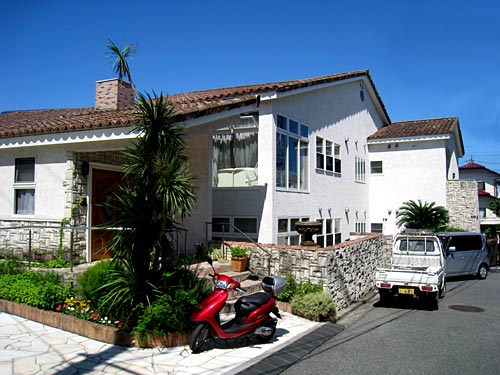
The entrance of an elderly care home in Yokohama - It looks like a Spanish resort house.
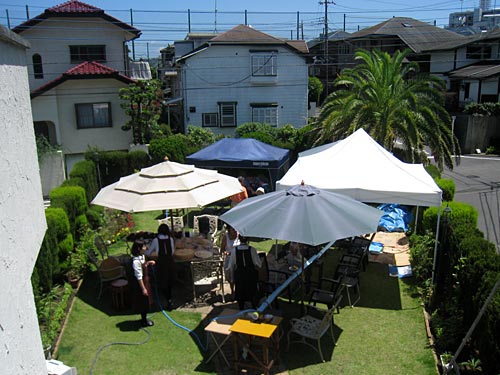
Neighboring houses and the garden of the elderly care house, where the floating noodle party took place.
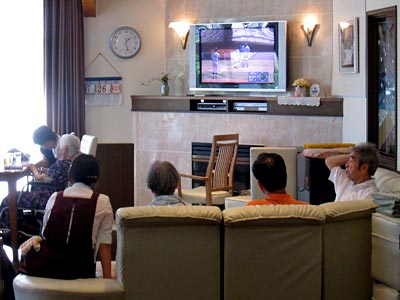
A part of the living room
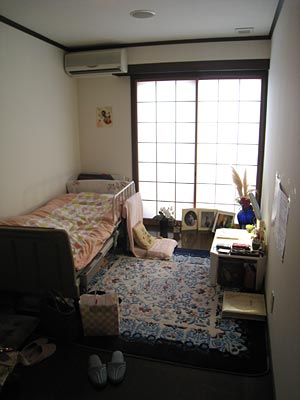
This is the private room of my step-mother. This single room has about 10 square meter, a bit smaller than other private rooms.
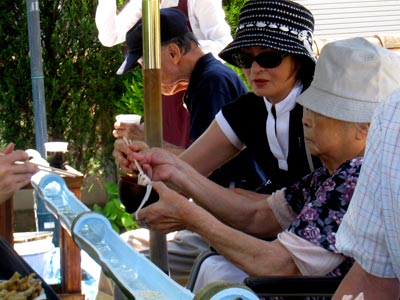
A woman helps her mother in picking up somen noodle.
 Recently elderly care has become one of the major social issues in Japan. In particular, elderly care becomes all the more troublesome, when elderly persons are demented. It is really touching to hear suicide cases, where a caretaker gets exhausted from the burden of long lasting care of an old spouse or parent and commits a double suicide. Today Japanese women have the world longest life expectancy of 86.05 years, while men the fourth-longest 79.29 years. However, long life is unfortunately not always an equivalent of long healthy and happy life.
Recently elderly care has become one of the major social issues in Japan. In particular, elderly care becomes all the more troublesome, when elderly persons are demented. It is really touching to hear suicide cases, where a caretaker gets exhausted from the burden of long lasting care of an old spouse or parent and commits a double suicide. Today Japanese women have the world longest life expectancy of 86.05 years, while men the fourth-longest 79.29 years. However, long life is unfortunately not always an equivalent of long healthy and happy life.In the 1950s and 60s, elderly care used to be done within the then still common big families and most seniors did not live too long to show symptom of dementia. The increase of average life length and the development of medicine has resulted in the longer care period for elderly people. At the same time, nuclear family came to prevail and the number of children decreased drastically. All these developments make it difficult for the family members to care the elderly people in the family and make it necessary to establish a social system to care the elderly.
In Japan an elderly care insurance system was introduced in April 2000. Since then various elderly care institutions have been built and the environment for elderly care has been improving, though far from perfect yet. One of the most serious problems is the chronicle shortage of care workers. When the economy started to suffer from the impact of the American sub-prime loan catastrophe, there came up an opinion that the elderly care sector could absorb the unemployed people. But, the recession only disclosed clearly the poor work conditions of care workers. Even unemployed people did not show much interest in working inthe elderly care sector, because it is extremely hard with unproportionately low salary.
Because I knew that the discussion about the work conditions is still going on, I was impressed by the cheerful and delightful attitudes of care workers when I recently visited a "group home" in which my step-mother lives for a year or so.
While my own parents live happily together in their own house, though they are already mid 80s, my step-mother started to show early symptoms of dementia, after her spouse died several years ago. Her two daughters, my wife and her younger sister, live since their marriage independently and find it difficult to care their mother around-the-clock in their own house from various reasons. Fortunately, we found a good elderly care home.
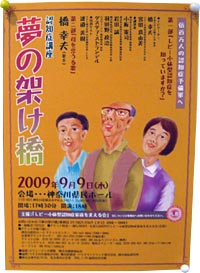 A pamphlet announcing the lecture on Dementia with Lewy Bodies. Famous pop singer Hashi Yukio also supports the activities. |
Group homes are built in high-quality residential area of Yokohama and divided into sections with nine residents each. The home where my step-mother is accommodated is built in the Spanish style and has a light and tidy interior. Two stories of the house have almost the same plan: on each floor, thre are nine personal rooms, a spacious living-dining with a fireplace and sanitary facilities. Even therapy dogs are kept in the homes.
Old residents are supported by almost the same number of care workers. Ordinary care workers are young and friendly, while their veteran chief and her deputy are experienced and real professionals. I was surprised to know that they not only support the residents in their daily life, starting from bringing them to toilet or giving them the prescribed doses of medicine, but also personally cook in the open kitchen on each floor the entire meal for the residents. It was heartwarming to watch a young male care workers try his best in cooking!
On this Sunday there were two special programs for the residents and their family members: nagashi-somen (flowing somen noodle) around noon and classical song concert in the afternoon.
"Flowing somen noodle" is a traditional entertainment using thin wheat noodle. It is a good training for old people, I believe, to pick up flowing noodles with chopsticks. One young male staff, graduate from a music university, played old school- and popular songs with saxophone. Lots of tempura, which had been cooked in all kitchens of the home, is served. Suddenly strong wind blew up a tent, but some workers and family members grasped down the flying tent and fortunately nobody was injured though a few pipes of the tent were bent.
In light of the debate on the poor working conditions of care workers, I wonder how the cost structure of the institution is maintained. Fees of the residents are high, but not as high as to conveniently cover all necessary expenditure, I presume. Maybe lots of tax money is paid in such activities and the young workers might not have affluent salary.
Anyhow, the workers practice extremely good relations with even difficult residents. The residents are treated just as queens and kings and their selfish wills are accepted to the maximum extent possible. This might be the reason that my step mother has recovered her sense and capability almost completely after she started to live in this home. A year ago, we did not have even a vague hope that she would ever improve her capability. Good human care can realize many things.
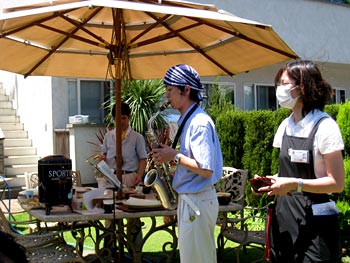
One of the young workers plays saxphone.